A Game Lane Changing Model Considering Driver’s Risk Level in Ramp Merging Scenario
Abstract
1. Introduction
1.1. Literature Review
1.2. Contribution
1.3. Paper Organization
2. Research on Driving Style under Lane-Changing Conditions
2.1. Extraction of Driving Style Features
2.2. Cluster Analysis by K-Means
3. Ramp Merge Decision Modeling
3.1. Ramp Merging Decision Modeling
- (1)
- The vehicles studied are all cars, excluding other types of vehicles, such as trucks;
- (2)
- We assumed that the FV is a human-driven vehicle equipped with V2X and V2V equipment;
- (3)
- We assumed that the merging vehicle EV studied in this paper is an autonomous vehicle and has been equipped with complete on-board sensors and wireless communication modules;
- (4)
- Only the acceleration and deceleration behavior of the FV is considered, and its lane-changing behavior is not considered.
3.2. Vehicle Kinematics Model
3.3. Definition of EV Cost-Function
3.4. Definition of Game Equilibrium
4. Quintic Polynomial Trajectory Planning with Multi-Constraints
5. Simulation and Verification
5.1. Simulation Parameter Setting
5.2. Model Simulation Test
6. Conclusions
Author Contributions
Funding
Institutional Review Board Statement
Informed Consent Statement
Data Availability Statement
Conflicts of Interest
References
- Wang, H.; Yuan, S.; Guo, M.; Li, X.; Lan, W. A deep reinforcement learning-based approach for autonomous driving in highway on-ramp merge. Proc. Inst. Mech. Eng. Part D J. Automob. Eng. 2021, 235, 2726–2739. [Google Scholar] [CrossRef]
- Zhu, J.; Tasic, I. Safety analysis of freeway on-ramp merging with the presence of autonomous vehicles. Accid. Anal. Prev. 2021, 152, 105966. [Google Scholar] [CrossRef]
- Ni, D.; Leonard, J.D. A simplified kinematic wave model at a merge bottleneck. Appl. Math. Model. 2005, 29, 1054–1072. [Google Scholar] [CrossRef]
- Kondyli, A.; Elefteriadou, L. Driver behavior at freeway-ramp merging areas based on instrumented vehicle observations. Transp. Lett. 2012, 4, 129–142. [Google Scholar] [CrossRef]
- Rios-Torres, J.; Malikopoulos, A.A. A Survey on the Coordination of Connected and Automated Vehicles at Intersections and Merging at Highway On-Ramps. IEEE Trans. Intell. Transp. Syst. 2017, 18, 1066–1077. [Google Scholar] [CrossRef]
- Stanton, N.A.; Salmon, P.M. Human error taxonomies applied to driving: A generic driver error taxonomy and its implications for intelligent transport systems. Saf. Sci. 2009, 47, 227–237. [Google Scholar] [CrossRef]
- Fagnant, D.J.; Kockelman, K. Preparing a nation for autonomous vehicles: Opportunities, barriers and policy recommendations. Transp. Res. Part A Policy Pract. 2015, 77, 167–181. [Google Scholar] [CrossRef]
- Metz, D. Developing Policy for Urban Autonomous Vehicles: Impact on Congestion. Urban Sci. 2018, 2, 33. [Google Scholar] [CrossRef]
- Letter, C.; Elefteriadou, L. Efficient control of fully automated connected vehicles at freeway merge segments. Transp. Res. Part C Emerg. Technol. 2017, 80, 190–205. [Google Scholar] [CrossRef]
- Lu, C.; Dong, J.; Houchin, A.; Liu, C. Incorporating the standstill distance and time headway distributions into freeway car-following models and an application to estimating freeway travel time reliability. J. Intell. Transp. Syst. 2021, 25, 21–40. [Google Scholar] [CrossRef]
- Xu, L.; Lu, J.; Ran, B.; Yang, F.; Zhang, J. Cooperative Merging Strategy for Connected Vehicles at Highway On-Ramps. J. Transp. Eng. Part A Syst. 2019, 145, 04019022. [Google Scholar] [CrossRef]
- Wang, Q.; Yang, X.; Huang, Z.; Yuan, Y. Multi-Vehicle Trajectory Design During Cooperative Adaptive Cruise Control Platoon Formation. Transp. Res. Rec. 2020, 2674, 30–41. [Google Scholar] [CrossRef]
- Dong, C.; Wang, H.; Li, Y.; Wang, W.; Zhang, Z. Route control strategies for autonomous vehicles exiting to off-ramps. IEEE Trans. Intell. Transp. Syst. 2019, 21, 3104–3116. [Google Scholar] [CrossRef]
- Lee, J.; Park, B.B. Evaluation of Variable Speed Limit under Connected Vehicle Environment. In Proceedings of the 2013 International Conference on Connected Vehicles and Expo (ICCVE), Las Vegas, NV, USA, 2–6 December 2013; pp. 966–967. [Google Scholar]
- Zhang, T.; Zhang, J.; Lu, M.; Lin, W.; Cong, Z. The Collaborative Control between CAVs under Highway Entrance Ramp and Exit Ramp Environment. In Proceedings of the 2018 3rd International Conference on Smart City and Systems Engineering (ICSCSE), Xiamen, China, 29–30 December 2018; pp. 547–551. [Google Scholar]
- Ji, A.; Levinson, D. A review of game theory models of lane changing. Transp. A Transp. Sci. 2020, 16, 1628–1647. [Google Scholar] [CrossRef]
- Talebpour, A.; Mahmassani, H.S.; Hamdar, S.H. Modeling lane-changing behavior in a connected environment: A game theory approach. Transp. Res. Procedia 2015, 7, 420–440. [Google Scholar] [CrossRef]
- Kita, H. A merging–giveway interaction model of cars in a merging section: A game theoretic analysis. Transp. Res. Part A Policy Pract. 1999, 33, 305–312. [Google Scholar] [CrossRef]
- Kita, H.; Tanimoto, K.; Fukuyama, K. A Game Theoretic Analysis of Merging-Giveway Interaction: A Joint Estimation Model. In Transportation and Traffic Theory in the 21st Century; Emerald Group Publishing Limited: Bingley, UK, 2002. [Google Scholar]
- Jing, S.; Hui, F.; Zhao, X.; Rios-Torres, J.; Khattak, A.J. Cooperative game approach to optimal merging sequence and on-ramp merging control of connected and automated vehicles. IEEE Trans. Intell. Transp. Syst. 2019, 20, 4234–4244. [Google Scholar] [CrossRef]
- Meng, F.; Su, J.; Liu, C.; Chen, W.-H. Dynamic Decision Making in Lane Change: Game Theory with Receding Horizon. In Proceedings of the 2016 UKACC 11th International Conference on Control (CONTROL), Belfast, UK, 31 August–2 September 2016; pp. 1–6. [Google Scholar]
- Liu, H.; Xin, W.; Adams, Z.; Ban, J. A Game Theoretical Approach for Modeling Merging and Yielding Behavior at Freeway on-Ramp Section. In Transportation and Traffic Theory: Papers Selected for Presentation at 17th International Symposium on Transportation and Traffic Theory, a Peer Reviewed Series Since 1959; Elsevier: Amsterdam, The Netherlands, 2007; pp. 197–211. [Google Scholar]
- Huang, W.; Kunfeng, W.; Yisheng, L.; FengHua, Z. Autonomous Vehicles Testing Methods Review. In Proceedings of the 2016 IEEE 19th International Conference on Intelligent Transportation Systems (ITSC), Rio de Janeiro, Brazil, 1–4 November 2016; pp. 163–168. [Google Scholar]
- Ilková, V.; Ilka, A. Legal Aspects of Autonomous Vehicles—An Overview. In Proceedings of the 2017 21st International Conference on Process Control (PC), Strbske Pleso, Slovakia, 6–9 June 2017; pp. 428–433. [Google Scholar]
- Ren, G.; Zhang, Y.; Liu, H.; Zhang, K.; Hu, Y. A new lane-changing model with consideration of driving style. Int. J. Intell. Transp. Syst. Res. 2019, 17, 181–189. [Google Scholar] [CrossRef]
- Song, X.-L.; Zeng, Y.-B.; Cao, H.-T.; Li, M.-J.; Yi, B.-L. Lane Change Intention Recognition Method Based on an LSTM Network. China J. Highw. Transp. 2021, 34, 236–245. [Google Scholar]
- Ye, M.; Pu, L.; Li, P.; Lu, X.; Liu, Y. Time-Series-Based Personalized Lane-Changing Decision-Making Model. Sensors 2022, 22, 6659. [Google Scholar] [CrossRef] [PubMed]
- Ali, Y.; Zheng, Z.; Mazharul Haque, M.; Yildirimoglu, M.; Washington, S. Understanding the discretionary lane-changing behaviour in the connected environment. Accid. Anal. Prev. 2020, 137, 105463. [Google Scholar] [CrossRef] [PubMed]
- Owen, G. Game Theory; Emerald Group Publishing: Bingley, UK, 2013. [Google Scholar]
- Yang, S.; Wang, Z.; Zhang, H. Kinematic Model Based Real-Time Path Planning Method with Guide Line for Autonomous Vehicle. In Proceedings of the 2017 36th Chinese Control Conference (CCC), Dalian, China, 26–28 July 2017; pp. 990–994. [Google Scholar]
- Hang, P.; Lv, C.; Huang, C.; Xing, Y.; Hu, Z. Cooperative decision making of connected automated vehicles at multi-lane merging zone: A coalitional game approach. IEEE Trans. Intell. Transp. Syst. 2021, 23, 3829–3841. [Google Scholar] [CrossRef]
- Hang, P.; Huang, C.; Hu, Z.; Lv, C. Decision making for connected automated vehicles at urban intersections considering social and individual benefits. IEEE Trans. Intell. Transp. Syst. 2022, 23, 22549–22562. [Google Scholar] [CrossRef]
- Liu, Y.; Wang, Y.; Wang, X.; Tao, C. A Model for Safe Lane Changing of Connected Vehicles Based on Quintic Polynomial Trajectory Planning. In Proceedings of the 2022 7th International Conference on Intelligent Informatics and Biomedical Science (ICIIBMS), Nara, Japan, 24–26 November 2022; pp. 51–55. [Google Scholar]
- GB/T13441.1—2007 [S]; Mechanical Vibration and Shock—Evaluation of Human Exposure to Whole—Body Vibration. China Quality Inspection Press: Beijing, China, 2007.
- Zhao, X. Research on Lane-Changing Trajectory Planning and Tracking Control Algorithms of Intelligent Vehicle. Ph.D. Thesis, Jilin University, Changchun, China, 2022. [Google Scholar]


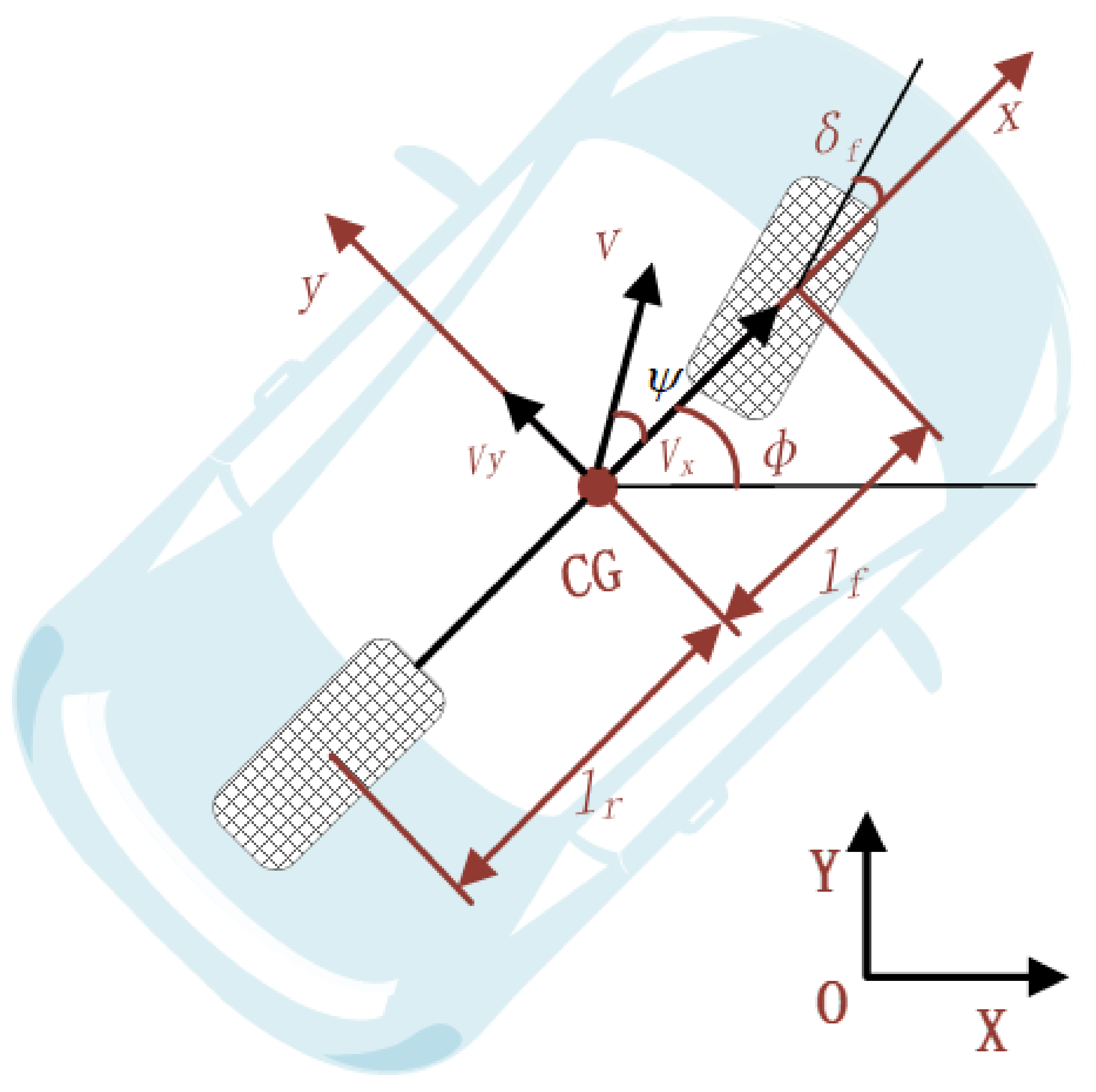
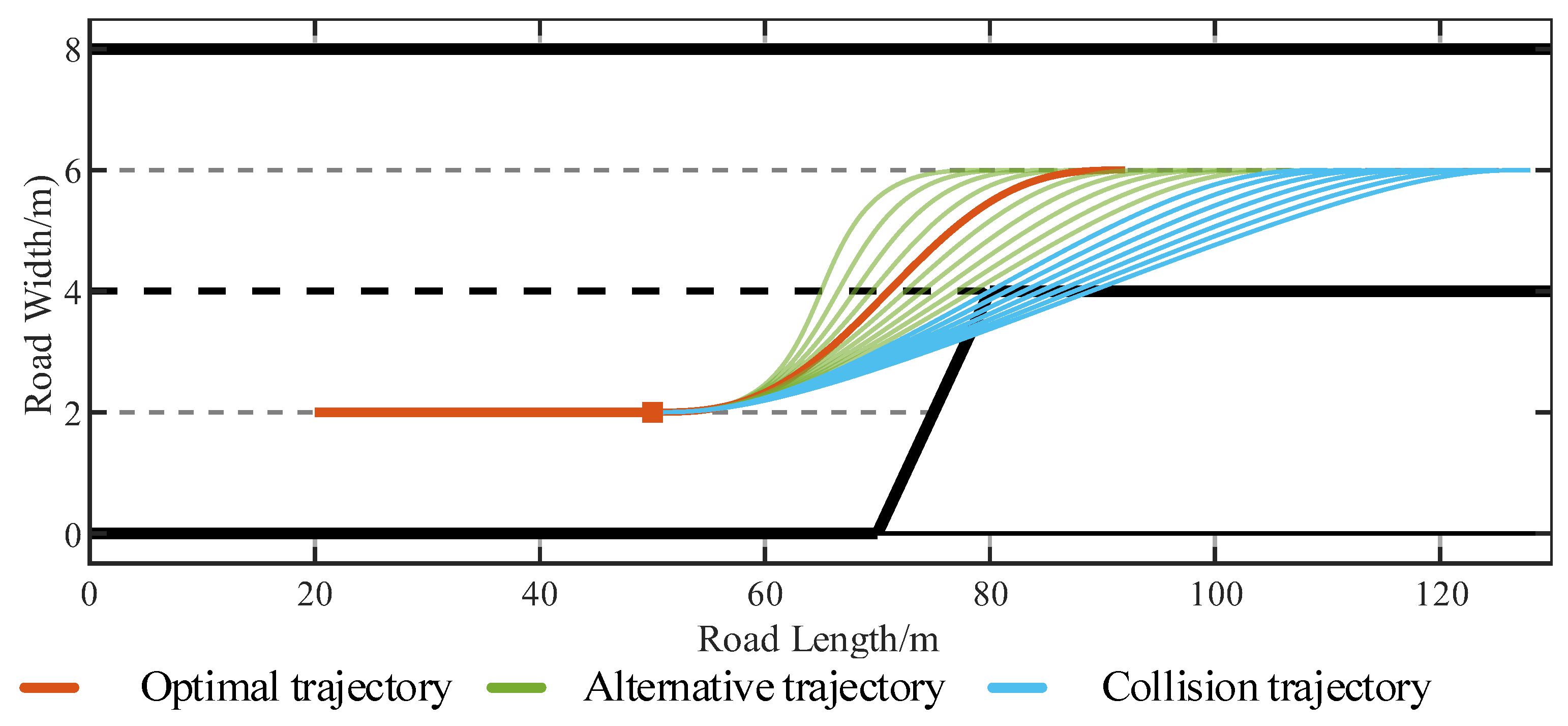


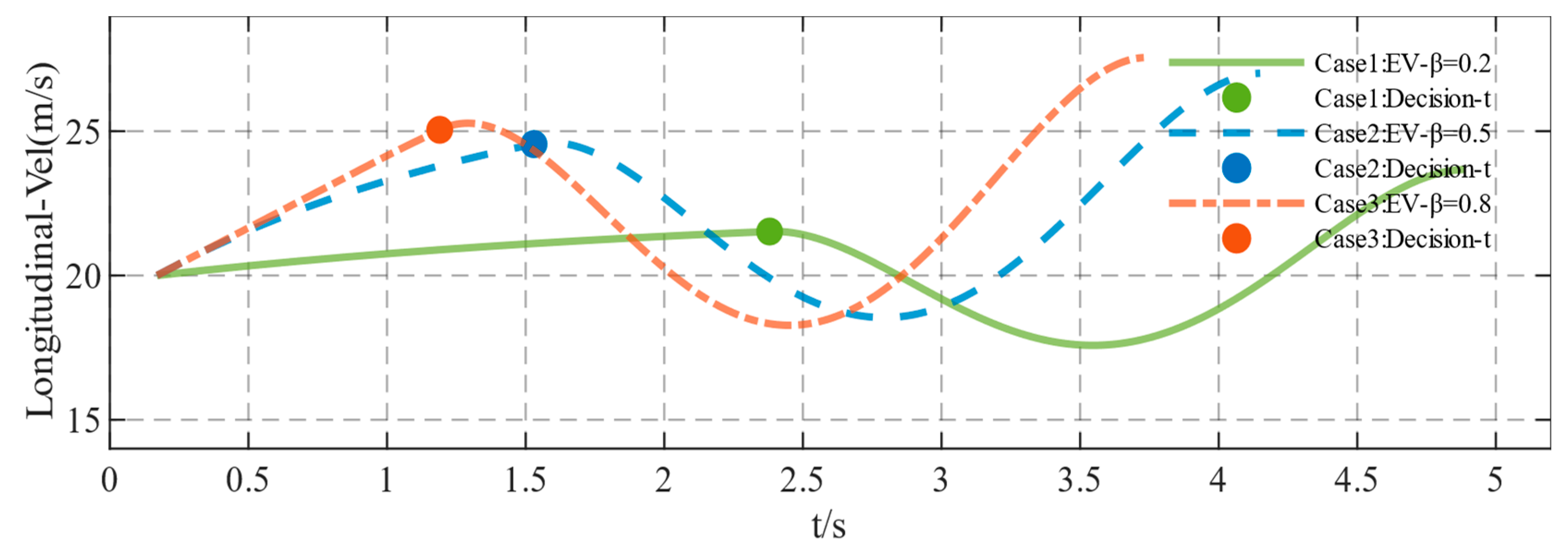
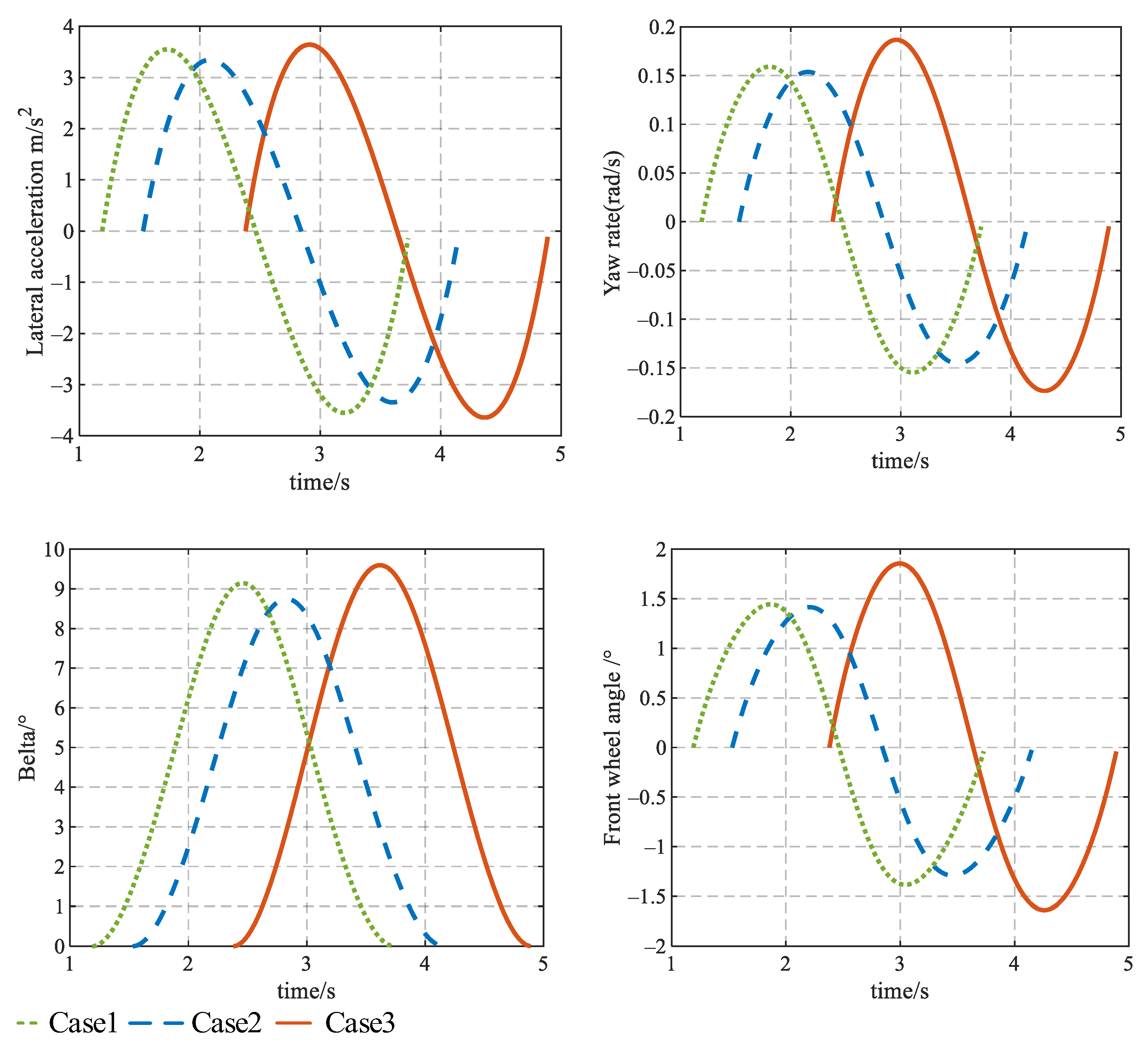
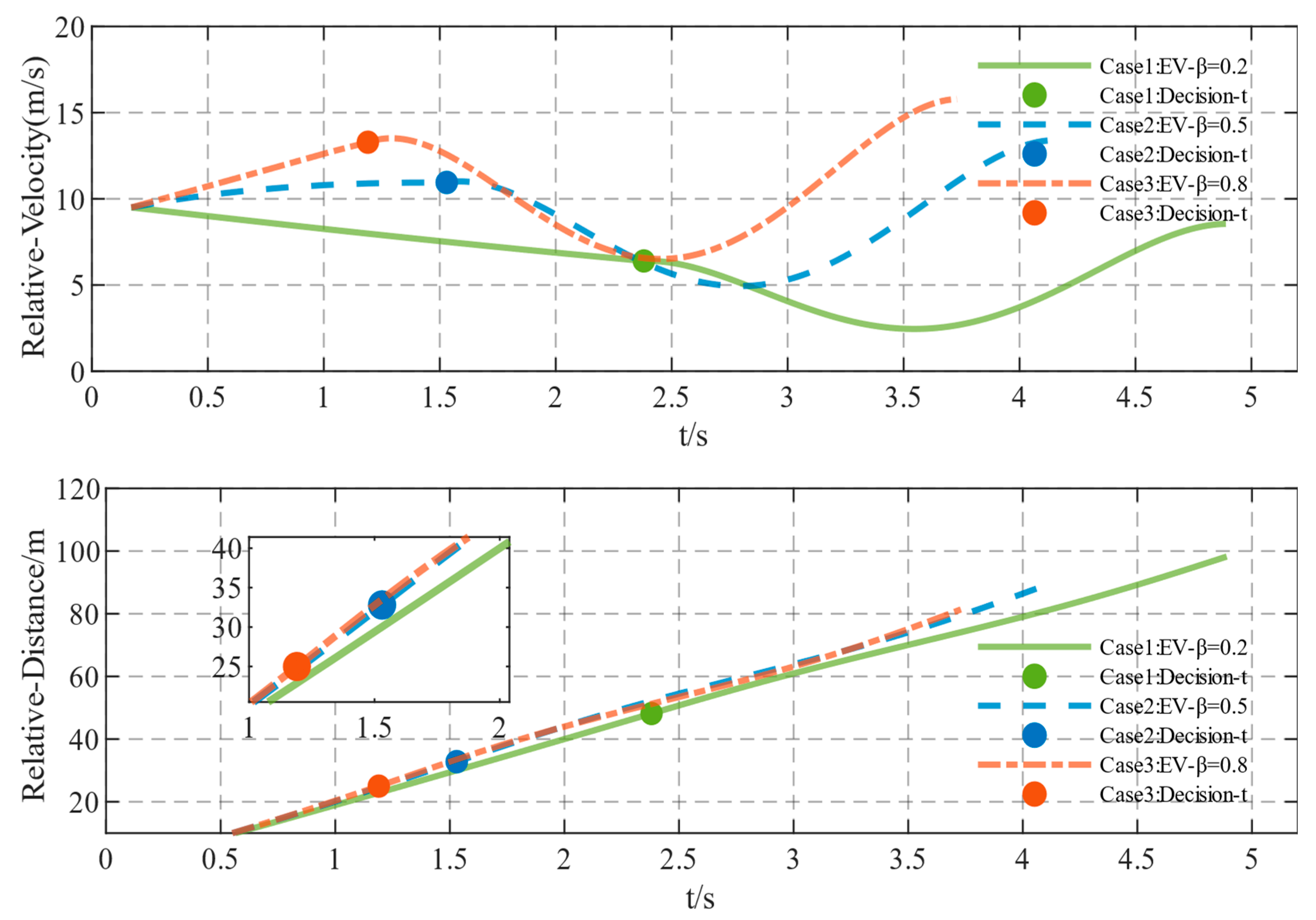
| Decision Making | The Following Vehicle | ||
|---|---|---|---|
| Strategy | Yield | Block | |
| Ego vehicle | Lane-changing | ||
| Wait | |||
| Decision Making | Trajectory Planning | ||||||
|---|---|---|---|---|---|---|---|
| 0.32 | 0.6 | 0.7 | ,/(m) | 1.4, 1.65 | |||
| 8 × 103 | 1 × 10−5 | (°) | 10 | 17 | |||
| 0.4 | /(m) | 20 | (°) | 2 | , (N/rad) | −264,570, −240,000 | |
| 7 × 103 | [−3, 5] | (rad/s) | 3 | (m/s2) | 0.4g | ||
| 0.45 | [−4, 5] | (kg) | 1650 | (m) | 60 | ||
| (m/s) | 30 | 2.1 | (m) | 3.05 | (s) | 14 | |
Disclaimer/Publisher’s Note: The statements, opinions and data contained in all publications are solely those of the individual author(s) and contributor(s) and not of MDPI and/or the editor(s). MDPI and/or the editor(s) disclaim responsibility for any injury to people or property resulting from any ideas, methods, instructions or products referred to in the content. |
© 2023 by the authors. Licensee MDPI, Basel, Switzerland. This article is an open access article distributed under the terms and conditions of the Creative Commons Attribution (CC BY) license (https://creativecommons.org/licenses/by/4.0/).
Share and Cite
Yang, G.; Liu, S.; Ye, M.; Tang, C.; Fan, Y.; Liu, Y. A Game Lane Changing Model Considering Driver’s Risk Level in Ramp Merging Scenario. World Electr. Veh. J. 2023, 14, 172. https://doi.org/10.3390/wevj14070172
Yang G, Liu S, Ye M, Tang C, Fan Y, Liu Y. A Game Lane Changing Model Considering Driver’s Risk Level in Ramp Merging Scenario. World Electric Vehicle Journal. 2023; 14(7):172. https://doi.org/10.3390/wevj14070172
Chicago/Turabian StyleYang, Guo, Shihuan Liu, Ming Ye, Chengcheng Tang, Yi Fan, and Yonggang Liu. 2023. "A Game Lane Changing Model Considering Driver’s Risk Level in Ramp Merging Scenario" World Electric Vehicle Journal 14, no. 7: 172. https://doi.org/10.3390/wevj14070172
APA StyleYang, G., Liu, S., Ye, M., Tang, C., Fan, Y., & Liu, Y. (2023). A Game Lane Changing Model Considering Driver’s Risk Level in Ramp Merging Scenario. World Electric Vehicle Journal, 14(7), 172. https://doi.org/10.3390/wevj14070172







